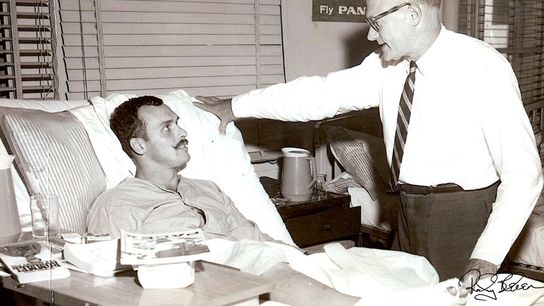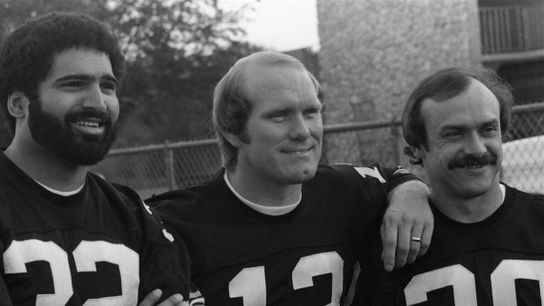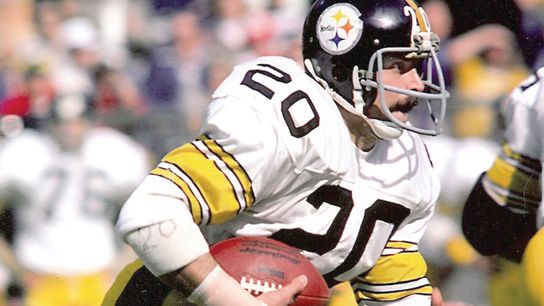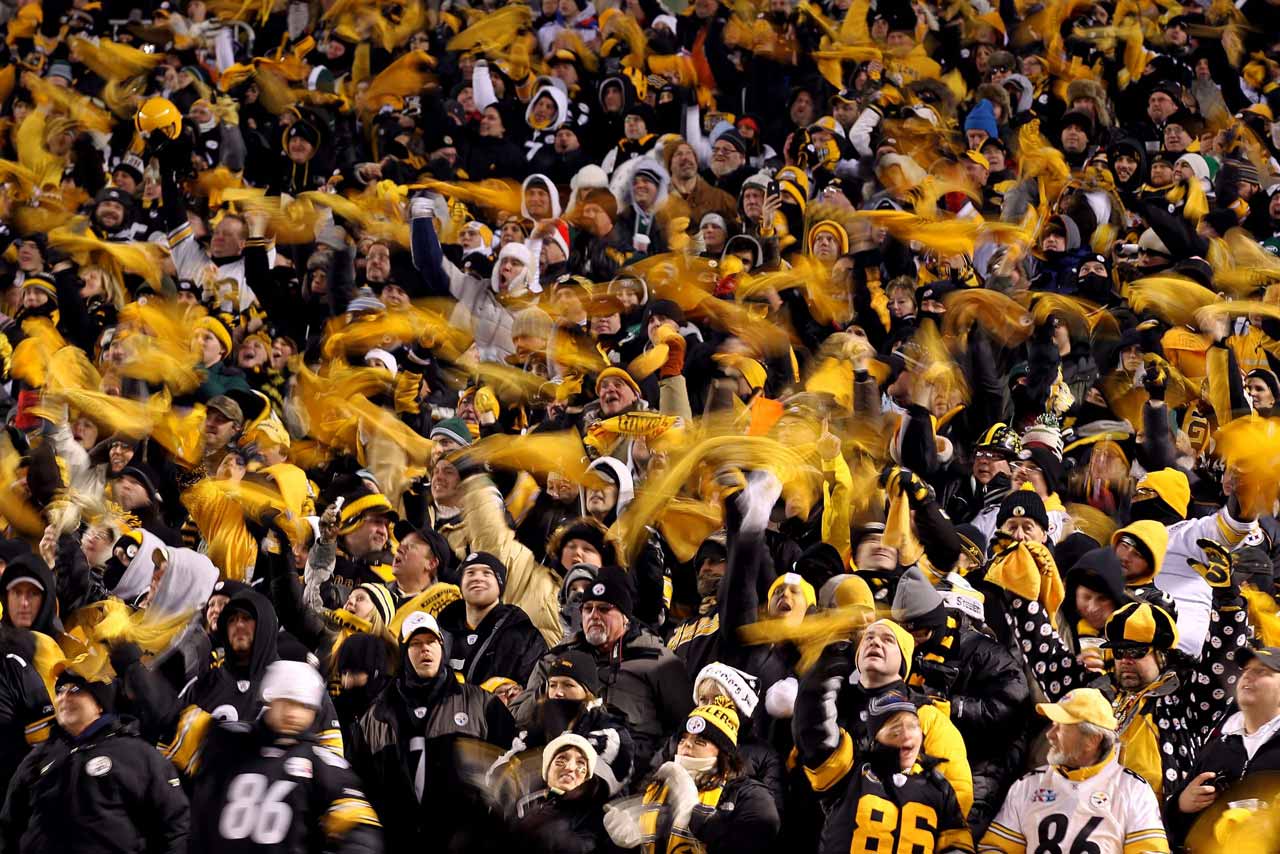The year was 1969 and the Pittsburgh Steelers were coming off an abysmal 2-11 record. Chuck Noll was preparing for his first season as Head Coach. The organization was still finding its way through the changing American football landscape as the AFL-NFL merger was announced in 1966. As the competitive landscape was in a state of transition for the Steelers, the entire country was engrossed in the Cold War and the turbulent geopolitical landscape. As a result, the United States military enacted a draft to call men across the country to fight in Vietnam.

Getty Images
Steelers' Rocky Bleier (#20) runs with the ball against the Cincinnati Bengals in Pittsburgh, PA.
After being drafted by the Steelers with the 417th overall selection in 1968, 22-year-old running back, Rocky Bleier was closing the books on a relatively mundane rookie season in Pittsburgh. He didn’t see much playing time and only logged 39 rushing yards on six carries with another 68 receiving yards on three receptions in 10 games.
As he was finishing up his first season in the NFL, he was called by the United States Army in December of 1968 and was subsequently shipped across the world in the early months of 1969 after his 23rd birthday. Once he landed in Vietnam, he found himself joining the ranks within the 196th Light Infantry Brigade as a grenadier. Bleier joined Alex Marvez on SiriusXM’s Great Americans of the NFL and relived his first wounds of the war, setting up for one of the biggest comebacks in history.
“As I stepped out on that rice paddy, about forty yards ahead of me, our point man saw movement across the berm and shots broke the stillness. The enemy started to run, he started to chase them, pulling everybody out into the middle of that rice paddy when all of a sudden, a machine gun started to level the area and bodies were diving left and right and I jumped in the rice paddy and found the machine gun nest. My responsibility was to get fire-power on that position. We had four guys who were pinned down, out in the open in front of us and so as I rolled over to fire my first grenade, I got hit the first time that day when a bullet pierced through my left thigh.”
As Bleier alluded, he would be wounded again that day. Just hours later, Bleier, a field medic and the commanding officer set up a defensive position as they waited for the medical evacuation helicopters to come rescue them. Bleier continued in sharing how he fell victim to another, much larger, wound.
“The enemy pulled their position or got close enough. We didn’t know what was taking place or what or who we ran into. When all of a sudden, a grenade comes flying through, and I see it out of the corner of my eye, and it hits my commanding officer on the back and he was right next to me and it bounces off his back and rolls between my feet and as I jumped to get out of the way, it blows up. I was standing on top of it and blew up through my right foot, knee, and thigh.”
After eventually finding his way out of the jungle, Bleier’s time in the army was seemingly over. When he got back to base, he was transferred to Tokyo, Japan where he spent three weeks in the hospital. Then, he spent another nine months in the hospital on his journey back to the United States. When it was all said and done, there was obviously incredible damage done to Bleier. That included muscular damage, nerve damage, tissue damage, broken bones and remaining shrapnel in his foot. To think that he could play professional football again was ignorant at the time.

Rocky Bleier/rockybleier.com
Rocky Bleier in the hospital in Tokyo, Japan following his injuries.
One Rooney Trumped Noll To Bring Back Bleier To The Steelers
Back in Pittsburgh, the Steelers were coming off another poor season after posting a 1-13 record in Noll’s first season as the Head Coach. Then-owner, Art Rooney Sr. was working with his son, Dan Rooney, on still trying to find the answer to get a winning season. The Rooneys knew what Bleier brought to the team and followed his journey across the globe. After learning of his injuries, Rooney Sr. saw his chance to recruit Bleier back to Pittsburgh to reignite his football career. Bleier revealed the postcard he got in the hospital that gave him a new football life.
“I get this postcard in the mail. It is just a simple postcard, and it had two lines on it, and it said this, ‘Rock, the team’s not doing well. We need you. Art Rooney,’ and it was like, wow, like a little sense of hope, you know, that somebody needed me.”
Bleier’s journey back to football is one that has been well documented and was one of extreme perseverance. But hidden in that was the stubbornness of Noll that almost left Bleier out of a job, and ultimately out of hope to ever play football again. As the team worked its way to the 1971 season, a tired, still-injured, beat-up Bleier made it through the first couple of rounds of cuts. But as training camp came to a close and the final cut deadline loomed, Bleier found himself in Noll’s office.
“I can remember going into [Noll's] office and him saying, ‘go home, do what what’s necessary, come back next year, and we’ll have a spot here for you to be able to come back,’ but then I argued about going to practice and so-on but the reality was that was the end of that dream at that moment in time.”
As Bleier left the team and took the night to rest and recalibrate his thoughts, he received a call that turned everything around. The call propelled Bleier back on track and allowed him to rejoin Noll and the team through the season. Bleier continued his story.
“The next morning, I got a call from Dan Rooney, and he apologized for not being there at the time, and he said, ‘I talked to Chuck. We’re going to put you on injured reserve and have our doctors take a look at you, and maybe, hopefully come back and be able to help us at the end of the year,’ and they did. I still had shrapnel in my foot and I had another operation on the foot and slowly it came back. But they bought me a year.”
The kindness and generosity of the Rooney family is something that is hard to come by in professional sports. We’ve seen similar gestures from the family as recent as Ryan Shazier’s story, but Bleier owes his professional football career to the Rooneys. Without Dan stepping in and talking with Noll in an effort to retain Bleier and help him through his recovery, there is no telling what would have happened to Bleier’s life after the army.

Morris Berman/Pittsburgh Post-Gazette
Steelers' Franco Harris (32), Terry Bradshaw (#12), and Rocky Bleier (#20) in the 1970's.
Bleier concluded his professional football career in 1980. After his 11 seasons with the Steelers, he sits ninth in the team’s history in career rushing yards with 3,855 yards. Included in those was the 1976 season, where he and running mate Franco Harris, each surpassed the 1,000-rushing-yards milestone on their way to winning their second Super Bowl in back-to-back seasons in Super Bowl X. Bleier would ultimately be a part of four Super Bowl-winning teams and remains as the Steelers’ very own American hero.
Did you know Rooney helped save Bleier’s football career? What is your favorite Bleier moment? Let us know in the comments below!
#SteelerNation


